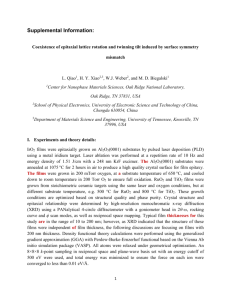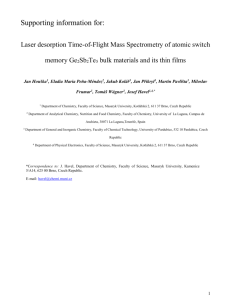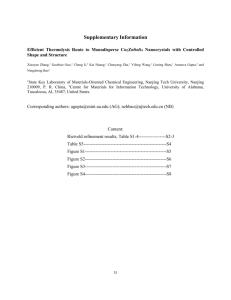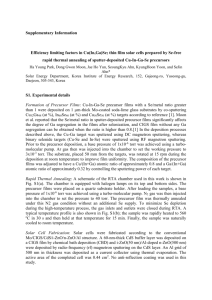11426_OF_15_0177 Supporting Information
advertisement
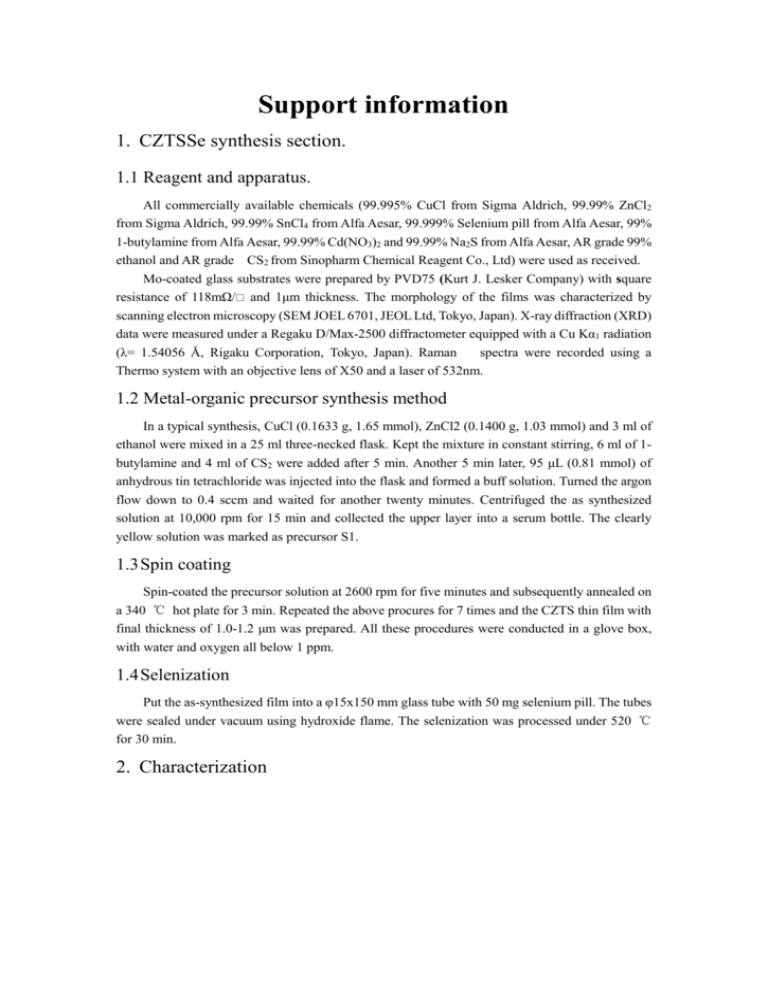
Support information 1. CZTSSe synthesis section. 1.1 Reagent and apparatus. All commercially available chemicals (99.995% CuCl from Sigma Aldrich, 99.99% ZnCl2 from Sigma Aldrich, 99.99% SnCl4 from Alfa Aesar, 99.999% Selenium pill from Alfa Aesar, 99% 1-butylamine from Alfa Aesar, 99.99% Cd(NO3)2 and 99.99% Na2S from Alfa Aesar, AR grade 99% ethanol and AR grade CS2 from Sinopharm Chemical Reagent Co., Ltd) were used as received. Mo-coated glass substrates were prepared by PVD75 (Kurt J. Lesker Company) with square resistance of 118mΩ/ and 1μm thickness. The morphology of the films was characterized by scanning electron microscopy (SEM JOEL 6701, JEOL Ltd, Tokyo, Japan). X-ray diffraction (XRD) data were measured under a Regaku D/Max-2500 diffractometer equipped with a Cu Kα1 radiation (λ= 1.54056 Å, Rigaku Corporation, Tokyo, Japan). Raman spectra were recorded using a Thermo system with an objective lens of X50 and a laser of 532nm. 1.2 Metal-organic precursor synthesis method In a typical synthesis, CuCl (0.1633 g, 1.65 mmol), ZnCl2 (0.1400 g, 1.03 mmol) and 3 ml of ethanol were mixed in a 25 ml three-necked flask. Kept the mixture in constant stirring, 6 ml of 1butylamine and 4 ml of CS2 were added after 5 min. Another 5 min later, 95 μL (0.81 mmol) of anhydrous tin tetrachloride was injected into the flask and formed a buff solution. Turned the argon flow down to 0.4 sccm and waited for another twenty minutes. Centrifuged the as synthesized solution at 10,000 rpm for 15 min and collected the upper layer into a serum bottle. The clearly yellow solution was marked as precursor S1. 1.3 Spin coating Spin-coated the precursor solution at 2600 rpm for five minutes and subsequently annealed on a 340 ℃ hot plate for 3 min. Repeated the above procures for 7 times and the CZTS thin film with final thickness of 1.0-1.2 μm was prepared. All these procedures were conducted in a glove box, with water and oxygen all below 1 ppm. 1.4 Selenization Put the as-synthesized film into a φ15x150 mm glass tube with 50 mg selenium pill. The tubes were sealed under vacuum using hydroxide flame. The selenization was processed under 520 ℃ for 30 min. 2. Characterization Figure 1 (a) XRD profiles of the as-synthesized films fabricated from different precursor S1. (b) Raman Spectra of the as-synthesized films fabricated from precursor S1. (c) XRD profiles of the selenized films fabricated from precursor S1. (d) Raman Spectra of the selenized films fabricated from precursor S1 Figure 1a shows the diffraction pattern of the CZTS thin films fabricated by precursor prepared in air (S1). In both case, three strong diffraction peaks (2θ=28.86°, 47.74°, 56.58°) are identical with the kesterite CZTS (JCPDS# 26-0575). There is no impurity peaks observed in the diffraction patterns except Mo from the substrate and a MoSe2 interfacial phase. However, the film fabricated by precursor synthesized in argon has a smaller FWHM at 2θ=28.86°. According to the Scherrer equation, a smaller FWHM indicates larger grains. We can conclude that the as-synthesized film fabricated by the precursor synthesized is composed of larger grains. Since the binary and ternary chalcogenides (e.g., ZnS, Cu2SnS3) X-ray diffractions overlap with CZTS pattern, it is impossible to demonstrate the film is single phase simply by XRD pattern. According to previous reports, the domain Raman Shift of CZTS can be posited at 331-338cm-1, with two additional peaks at 287 and 368cm-1.Figure 1b shows that the major peak of films prepared by S1 is located in 332 cm-1, 287 cm-1 and 368 cm-1. Figure 1c shows the XRD profiles of the selenized film (CZTSSe)made from S1. Compared with standard XRD data of CZTS (JCPDS#26-0575) and CZTSe (JCPDS#52- 0868), the selenized film diffraction peak located between them. As we know, the S/Se ration could affect the diffraction peak position. There is no impurity peaks observed, other than the Mo from substrate and MoSe2 from interfacial. This has proved that the selenized films were CZTSSe. Figure 1d gives the Raman Spectra of the CZTSSe thin films. A major peak located at 195 cm-1 with two additional peaks at 173 and 235 cm-1 and the S-S vibration shifted to 327cm-1 is in accordance with previous report. Figure 2 shows the SEM of CZTSSe thin films. Figure 2 The SEM of CZTSSe thin film. 3. The growth of CdS on the CZTSSe film The CZTSSe film was successively immersed into 1 M aqueous Cd(NO3)2 and 1 M aqueous Na2S for 1 min each. Following each immersion, the film was rinsed by deionized water for 2 min to remove excess precursors before the next dipping. This immersion cycle was repeated three times.
